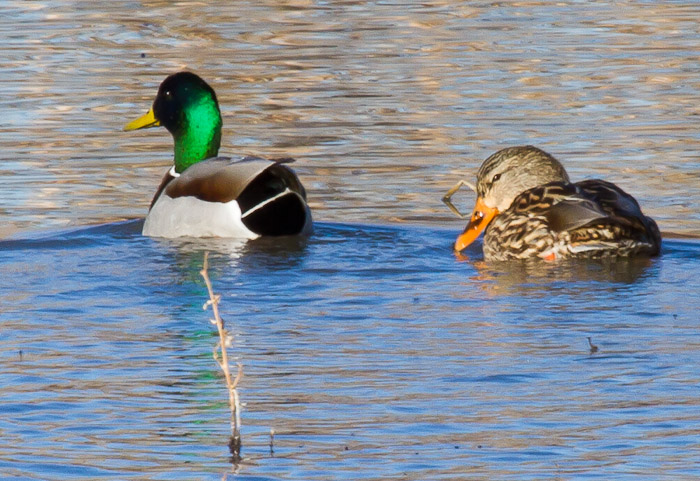Friday, January 28, 2011 - Bosque Birdwatchers RV Park, San Antonio NM
< previous day | archives | next day >

Mallards, Bosque del Apache National Wildlife Refuge, San Antonio NM, January 24, 2011
Why do ducks swim in a row?
Is it really as simple as follow-the-leader being the easiest way to move a group through the reeds as suggested by Yahoo!7 Answers? Sounds good for followers but what's in it for the leader?
Movement in a column is always the fastest way to move when there are obstacles, and there are always obstacles on the ground. If the group has to swim through some reeds, or go around an angry heron, it's easiest to just follow the leader. Swimming in a spread out formation requires teamwork which most animals aren't willing to commit to.
In addition, moving behind the leader allows you to draft, reducing the amount of drag you face, but this is only relevant if you are pretty close.
Source:Yahoo!7 Answers
A little about Mallards
The Mallard is a rare example of both Allen's Rule and Bergmann's Rule in birds. Bergmann's Rule, which states that polar forms tend to be larger than related ones from warmer climates, has numerous examples in birds. Allen's Rule says that appendages like ears tend to be smaller in polar forms to minimize heat loss, and larger in tropical and desert equivalents to facilitate heat diffusion, and that the polar taxa are stockier overall. Examples of this rule in birds are rare, as they lack external ears. However, the bill of ducks is very well supplied with blood vessels and is vulnerable to cold.
Source: Wikipedia
Night camp
Site 10 - Bosque Bird Watcher's RV Park, San Antonio NM
- This is a basic, small Mom & Pop RV Park with full hookups.
- Verizon cell phone and Broadband service are available here with a strong signal.
- Locate Bosque Bird Watcher's RV Park on my Night Camps map
- Click for Google street view
- Check the weather in San Antonio NM
I Tremble for my Species
Laughter is the sunshine of the soul.